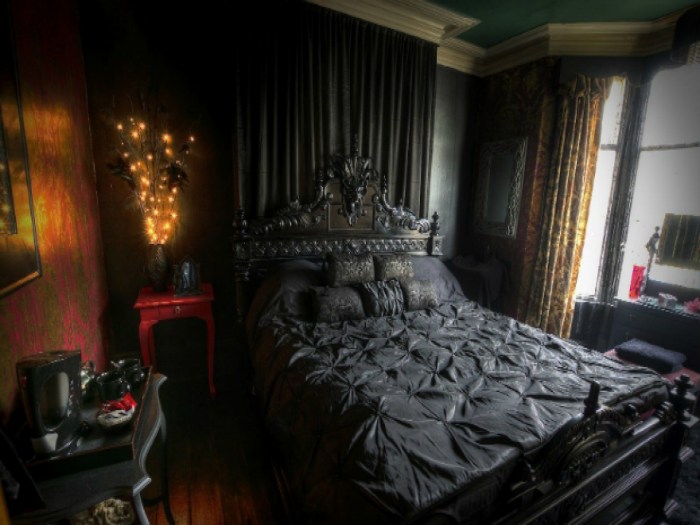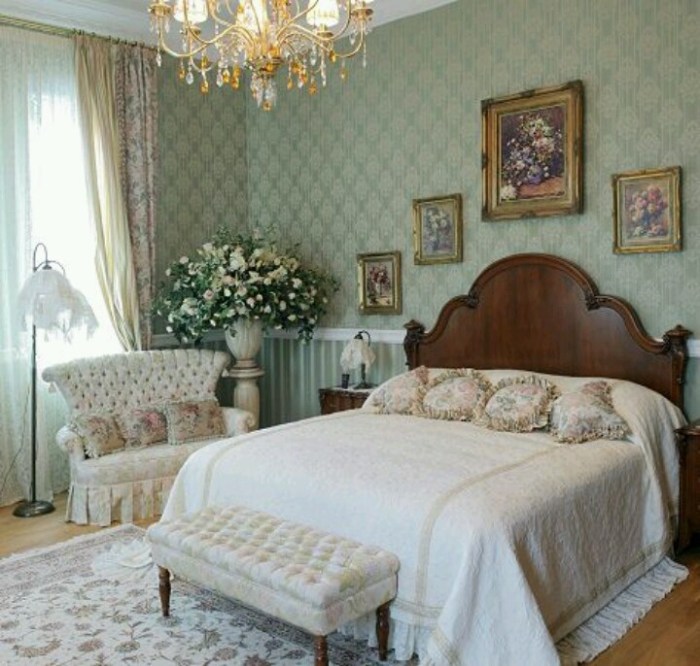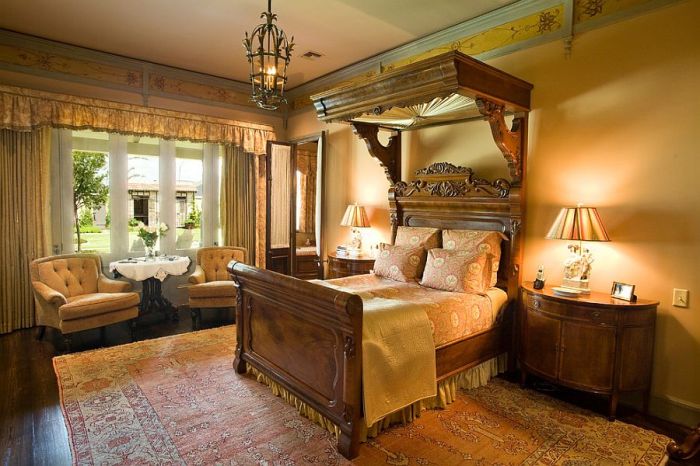Step into the realm of timeless elegance with Victorian era inspired bedroom design. This captivating style evokes the opulent grandeur of the 19th century, offering a sanctuary of comfort and sophistication. From ornate details to rich colors and plush fabrics, every element contributes to a space that exudes both historical charm and modern functionality.
Prepare to be transported to a bygone era as we delve into the intricate characteristics of Victorian bedroom design. From the vibrant color palette to the sumptuous furnishings, we’ll uncover the secrets to creating a space that blends the allure of the past with the conveniences of the present.
Victorian Era Design Characteristics
The Victorian era, spanning from the mid-19th century to the early 20th century, was a period of significant artistic and cultural change. Victorian design, particularly in interior decoration, is characterized by its opulence, intricate detailing, and eclectic mix of influences.
Victorian-inspired bedrooms are known for their rich and elaborate ornamentation, with a focus on creating a luxurious and inviting space. The use of ornate details, such as carved woodwork, decorative moldings, and elaborate fabrics, is a defining feature of this style.
Use of Ornate Details
Ornate details are a key element of Victorian design, adding a sense of grandeur and opulence to any space. In bedrooms, this can be seen in the intricate carvings on headboards and bed frames, as well as the use of decorative moldings and cornices around the room.
Carved woodwork was a popular way to add detail to Victorian furniture, with intricate patterns and motifs often used to decorate headboards, footboards, and other pieces.
Rich Colors and Patterns
Victorian-inspired bedrooms often feature rich and vibrant colors, with deep reds, greens, and blues being particularly popular. These colors were often paired with contrasting patterns, such as florals, stripes, and damasks.
The use of bold colors and patterns created a visually stimulating and opulent atmosphere, reflecting the Victorian era’s love of luxury and excess.
Heavy Fabrics and Textiles
Heavy fabrics and textiles were another important element of Victorian design. Velvet, silk, and damask were commonly used for curtains, upholstery, and bed linens, adding a sense of warmth and luxury to the space.
The use of heavy fabrics also helped to create a sense of privacy and seclusion, which was important in the Victorian era when bedrooms were often used for both sleeping and entertaining guests.
Color Palette and Patterns
The Victorian era was a time of opulence and grandeur, and this was reflected in the interior design of the period. Bedrooms were typically decorated in rich colors and elaborate patterns, creating a sense of luxury and comfort.
Traditional Color Palette
- Deep reds, such as burgundy and maroon
- Dark greens, such as emerald and forest green
- Blues, such as navy and royal blue
- Purples, such as amethyst and plum
- Gold and silver
Modern Color Palette
While traditional Victorian colors are still popular, there are also a number of more modern hues that can be used to create a Victorian-inspired bedroom. These include:
- Light pinks and blues
- Soft yellows and greens
- Neutral colors, such as white, cream, and gray
Patterns
Victorian-era bedrooms were often decorated with elaborate patterns, such as florals, damasks, and stripes. These patterns were typically used on wallpaper, bedding, and curtains.
- Florals: Floral patterns were one of the most popular choices for Victorian bedrooms. They were often used on wallpaper and bedding, and could feature a variety of different flowers, such as roses, lilies, and daisies.
- Damasks: Damask patterns were another popular choice for Victorian bedrooms. They were often used on curtains and upholstery, and could feature a variety of different designs, such as paisleys and scrolls.
- Stripes: Stripes were also a popular choice for Victorian bedrooms. They were often used on wallpaper and bedding, and could be either vertical or horizontal.
Incorporating Colors and Patterns
When incorporating colors and patterns into a Victorian-inspired bedroom, it is important to create a balance between opulence and comfort. Too many dark colors and heavy patterns can make the room feel oppressive, while too many light colors and simple patterns can make the room feel bland.
A good way to create a balanced look is to use a mix of dark and light colors, and to use patterns in moderation. For example, you could use a deep red wallpaper with a light floral pattern, or you could use a neutral-colored bedding with a bold damask pattern.
Furniture and Furnishings
The Victorian era was known for its elaborate and ornate furnishings, and the bedroom was no exception. Essential furniture pieces included beds, dressers, and chairs, each crafted with intricate details and luxurious materials.
When arranging the furniture, symmetry was key. The bed was typically placed in the center of the room, with matching nightstands on either side. The dresser was often placed opposite the bed, with a mirror above it. Chairs were placed around the room, creating a cozy and inviting space.
Beds
Victorian beds were grand and imposing, often made of mahogany or walnut. They featured elaborate headboards and footboards, which were often carved with intricate designs. The mattresses were filled with horsehair or feathers, making them both comfortable and supportive.
Dressers
Victorian dressers were also made of mahogany or walnut, and they featured multiple drawers for storage. The drawers were often decorated with brass or porcelain handles, and the dresser itself was often topped with a marble or granite slab.
Chairs
Victorian chairs were typically made of mahogany or walnut, and they featured upholstered seats and backs. The upholstery was often made of velvet or silk, and the chairs were often decorated with fringe or tassels.
Lighting and Accessories
In Victorian era bedrooms, lighting played a crucial role in creating an atmosphere of both opulence and comfort. Chandeliers, sconces, and oil lamps were the primary sources of illumination, each contributing to the distinct ambiance of the space.
Natural Light
Incorporating natural light into Victorian era bedroom designs was essential. Large windows, often adorned with elegant curtains, allowed ample sunlight to flood the room, creating a bright and airy atmosphere during the day. Bay windows, with their extended sills and multiple panes, were particularly popular, offering panoramic views and maximizing natural light.
Lighting Fixtures
Chandeliers, suspended from the ceiling, were the grandest lighting fixtures in Victorian era bedrooms. They featured intricate designs, often made of crystal or brass, and provided ample illumination for the entire room. Sconces, mounted on walls, offered more focused lighting, perfect for reading or dressing.
Oil lamps, with their soft, warm glow, added a touch of intimacy and romance to the space.
Accessories
Accessories played a vital role in enhancing the Victorian aesthetic of bedrooms. Mirrors, with their ornate frames, reflected light and created the illusion of space. Artwork, depicting scenes from nature or romantic themes, added a touch of elegance. Textiles, such as curtains, bedspreads, and pillows, in rich colors and intricate patterns, completed the opulent ambiance.
Wall Treatments and Flooring
Victorian era bedrooms showcased an array of intricate wall treatments and flooring options that contributed to their opulent and inviting ambiance. These elements worked in harmony to create a cohesive and visually stunning design scheme.
Wall Treatments
Wallpapers were immensely popular during the Victorian era, featuring elaborate patterns, vibrant colors, and flocked or embossed textures. Common motifs included florals, damasks, stripes, and geometric designs. For a more subdued look, paint was also used, often in shades of cream, ivory, or soft pastels.
Wood paneling was another elegant choice for Victorian era bedrooms. Mahogany, walnut, and oak were frequently employed, adding warmth and sophistication to the space. Paneling could be painted or stained to complement the overall color scheme.
Flooring
Hardwood floors were a prevalent choice for Victorian era bedrooms, particularly in the form of parquetry or herringbone patterns. These floors exuded elegance and durability, and could be polished to a high sheen. Carpets were also widely used, providing warmth and comfort underfoot.
They often featured intricate patterns and rich colors, adding a touch of opulence to the room.
Tile flooring was occasionally used in Victorian era bedrooms, particularly in areas with high moisture, such as bathrooms or dressing rooms. Tiles could be plain or patterned, and were often arranged in geometric designs.
Last Point
As we bid farewell to our journey through Victorian era inspired bedroom design, let us cherish the timeless beauty it embodies. Whether you seek to create a grand sanctuary or a cozy retreat, this style offers an endless canvas for expressing your individuality.
Embrace the intricate details, vibrant colors, and luxurious fabrics that define this era, and transform your bedroom into a space that evokes both nostalgia and timeless elegance.



